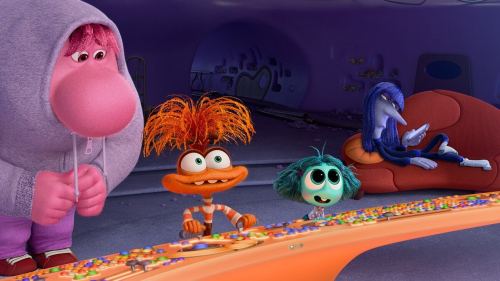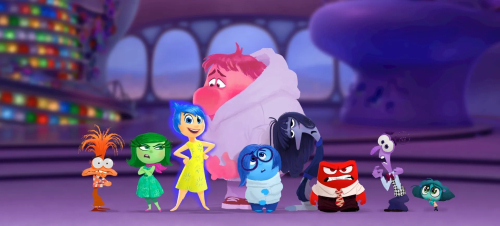
Inside Out 2 review



Inside Out 2
When Pixar announced the release of Inside Out 2, my anticipation was palpable. I couldn't help but reflect on the first installment, a film that masterfully captured the emotional world of an 11-year-old child. Now, having witnessed my own kids transform from those innocent years into full-blown teenagers, I was curious to see how the sequel would encapsulate the unique nuances of adolescence.
The film begins with a now-teenage Riley heading off to a weekend hockey camp. For those of us who have experienced the trials and triumphs of adolescence, this setting immediately resonates. The joys and challenges of team sports serve as a perfect backdrop for an exploration of the rich emotional landscape that defines teenage life. What stood out to me was not only the evolving dynamics within Riley's mind but also the ways in which these changes impact her relationships and decisions in the real world.
The Evolution of Riley's Emotions
The transition from childhood to adolescence is monumental, and Inside Out 2 does a commendable job portraying this shift. We delve into the workings of Riley's mind as it undergoes a transformation, with new emotions like Anxiety, Embarrassment, Envy, and Ennui taking center stage. Gone are the simpler days of Joy, Sadness, and Anger. In their place, this complex ensemble reflects the true roller-coaster ride of teenage feelings.
The film skillfully balances humor and poignancy. While the original offered a more playful exploration of emotions, this sequel captures the intricate, often overwhelming experience of growing up. Each emotion is given its own arc, exploring how they assert their influence on Riley's thoughts and actions. Anxiety, as the prominent driver, encapsulates the uncertainty that often accompanies new experiences and self-discovery.
A Relatable Antagonist
If there is an antagonist in Inside Out 2, it is not a villain in the traditional sense. Instead, Anxiety plays this role, presenting challenges and obstacles for Riley to confront. From my perspective, this is a brilliant choice. As we watch Riley grapple with her feelings, it's hard not to see our own experiences mirrored on screen. This reflection of our inner struggles makes the film not only compelling but deeply relatable.
Throughout the movie, Anxiety is the catalyst for many of Riley's poor decisions. Yet, her choices are always understandable and come from a place of fear or uncertainty. We see her act out, not out of malice, but from the instinct to protect herself, a common defense mechanism during the teenage years.
The Journey of Self-Discovery
The weekend at hockey camp serves as a microcosm for the transformative years of adolescence. What impressed me was how the filmmakers managed to condense what often feels like an eternity into a single weekend. The condensed timeline heightens the drama and allows for an intense, focused exploration of Riley's internal struggles.
In essence, the camp setting becomes a catalyst for personal growth. Friendships are tested, new relationships are formed, and Riley begins to understand the importance of self-awareness and emotional intelligence. Watching her navigate these waters reminded me of my own coming-of-age journey—the triumphs and heartbreaks that defined those formative years.
The Impact on Parents
As a parent, watching Inside Out 2 is both amusing and eye-opening. One particular scene where Riley snaps at her mother resonated with me on a personal level. "Well, that’s a preview of the next ten years," quips one of the mother's emotions. It’s a humorous yet stark reminder of the journey many of us are on as parents of teenagers.
The film offers a unique vantage point into the emotional turmoil parents experience as they witness their children's transition into adulthood. It captures the delicate balance of guiding them while also stepping back, allowing them to make mistakes and learn from their own experiences.
Animation and Visuals
Pixar, as always, brings a vibrant and visually stunning world to life. The colorful, dynamic depiction of Riley’s mind offers a visual treat that is both imaginative and engaging. Each emotion is carefully crafted to embody its essence, from Anxiety's jitteriness to Embarrassment's flushed cheeks.
The animation serves not only as eye candy but as an integral part of storytelling. Through subtle visual cues, we're given deeper insights into Riley's psyche, making the journey through her mind all the more immersive and captivating.
Music and Sound Design
Michael Giacchino returns with another evocative score, providing the perfect backdrop to this emotional journey. The music is an essential component, amplifying the tension and tenderness of each scene. It seamlessly weaves through the narrative, enhancing the storytelling without overpowering it.
The sound design also deserves applause, with a nuanced approach that incorporates everything from the chaotic jumble of competing emotions to the quiet introspection of self-discovery. This auditory landscape adds depth and texture to the film, creating an immersive experience that resonates long after the credits roll.
Thematic Depth
Inside Out 2 explores several themes, each woven into the fabric of the narrative with care and precision. At its core, the film delves into the struggle for identity—a universal theme that resonates with both teens and adults. Riley’s journey is a reflection of the confusion and exhilaration that accompany this quest for self-understanding.
Another theme that stood out is resilience. As Riley navigates the choppy waters of adolescence, viewers are reminded of the importance of bouncing back from setbacks, learning from missteps, and forging ahead with newfound wisdom. This message is especially poignant in today’s fast-paced, ever-changing world.
Character Development
Character development is one of the film's strongest suits. Riley's growth from a confused, anxious teen into a more self-aware individual is portrayed with subtlety and finesse. We witness her grapple with insecurity and self-doubt, and her eventual triumphs feel well-earned and genuine.
The supporting characters, particularly Riley’s emotions, also undergo significant growth. Each emotion is given room to evolve, providing insights into how they collectively contribute to Riley’s overall well-being. This development adds complexity and richness to the narrative, making it a truly multifaceted tale.
Representation and Inclusivity
While animation often has the tendency to lean toward the conventional, Inside Out 2 takes meaningful strides in representation. The film recognizes the diversity of the teenage experience and portrays it with authenticity. From different body types to varied personalities, the inclusion is commendable and creates a world that feels closer to reality.
This representation doesn’t feel tokenistic but rather a natural reflection of the varied world we live in. It’s refreshing to see a beloved animated feature embrace this level of inclusivity, offering viewers a story they can see themselves in.
The Importance of Friendship
Friendship as a theme runs throughout Inside Out 2, highlighting its importance during the turbulent teenage years. Friendships during adolescence often play a crucial role in shaping one's self-image and values. In the film, Riley's interactions with her peers serve as a reminder that friendships can both challenge and support us in significant ways.
This theme is beautifully rendered, showcasing both the positive and negative aspects of friendships and their profound impact on our emotional landscape, especially in formative years.
Lessons for Young and Old
While Inside Out 2 primarily targets a younger audience, its lessons transcend age. From teaching self-compassion to understanding the inevitability of change, the film offers food for thought for both teens and adults. It encourages introspection and empathy, nudging viewers to consider their own emotional responses and growth.
For parents, the film’s insights into the adolescent mind serve as valuable lessons in understanding and patience. It reinforces the idea that children and parents are simultaneously on a journey of growth, each navigating their own complexities and challenges.
A Universal Story
Though centered on a single character, Inside Out 2 tells a universal story—one of growing up, navigating change, and finding one’s voice. It speaks to the shared experiences of confronting fears, making mistakes, and ultimately learning to embrace the multitude of emotions that make us human.
This universality is what makes the film resonate with such a broad audience. It taps into emotions and experiences that are innately familiar yet often challenging to articulate. In doing so, it offers solace, understanding, and a sense of connection.
Concluding Thoughts
In conclusion, Inside Out 2 is a triumphant return for Pixar, capturing the intricacies of teenage life with grace, humor, and sensitivity. The film offers a vivid window into the emotional world of adolescents, rendering the complexities of growing up with a deft touch.
While it distilled the long and often arduous journey of adolescence into a single weekend, it did so with great finesse, leaving me with a renewed appreciation for the emotional landscape of teenagers. If you have teens or have ever been one, this is a cinematic experience that should not be missed. It’s a reminder that though the path may be fraught with challenges, it is also filled with opportunities for growth, connection, and understanding.




















Leave a comment
Your comment is awaiting moderation. We save your draft here
0 Comments